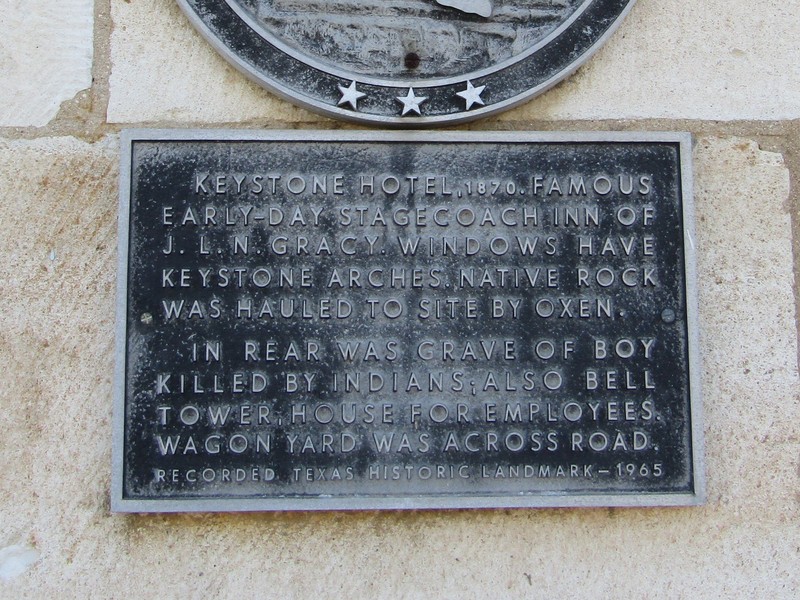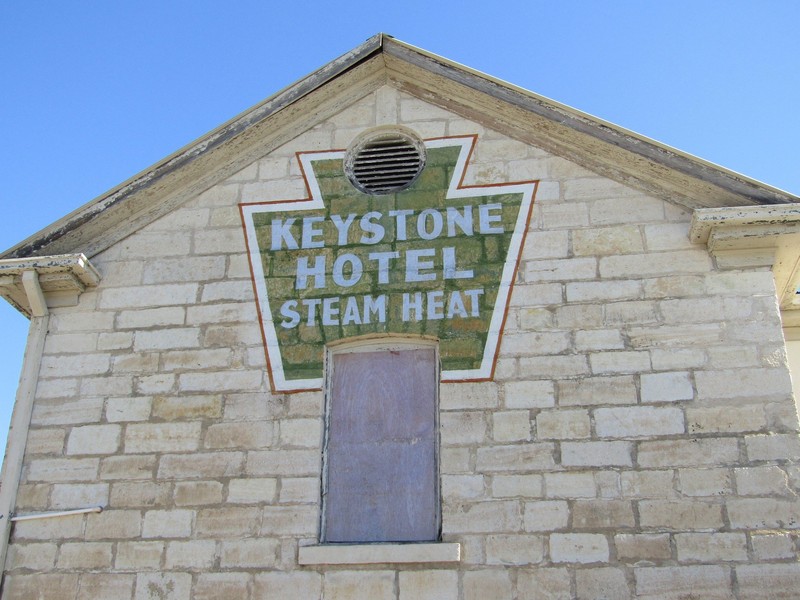The Keystone Star Hotel
Introduction
Text-to-speech Audio
Images
Top of the front of the building

side view of the front of the building

State historical plaque

top of the right side of the building

Dinner bell cast in New York 1860

Backstory and Context
Text-to-speech Audio
This historic stagecoach inn got its start in 1870 under the name The Star Hotel. It was built from locally sourced cut limestone by the stonemason Charles Royston Green, and was owned and operated by Mr. and Mrs. John N. Gracy. Some of the local Lampasas residents at the time referred to it as The Gracy Hotel. With the leftover limestone and other materials, Mr. Green built the “Little Hotel” a block away from The Star. Certain details like the windows, doors, and fireplaces matched the larger hotel.[1] It cost .50 cents a night to stay at The Star Hotel, but only .25 cents a night at The Little Hotel. John and Harriet Gracy lived and worked in the hotel and all 13 of their children were born there.[2]
All ten bedrooms, five on the first floor and five on the second, were equipped with a double bed, a fireplace, a dresser, a wash stand, a pitcher and bowl, and a chair. The hotel also included a wood floor gallery, a dining room, a kitchen, and a beautiful courtyard. Men’s and women’s bathroom were located on each floor and along the fence out back were six outhouses. The hotel attracted all different kinds of visitors from weary travels exiting the train depot across the street, to residents escaping bad weather like the flood of 1873. Cowboys also made up some of the clientele, however most of them could not afford the rent so the Gracy’s allowed them to stay in bunks in the attic for free. The cook could produce almost 500 meals a day out of the one room kitchen, and to alert the guests and nearby town residents of the upcoming meal she would ring the large bell in the courtyard that was cast in 1860 in New York City. All meals were served family style on long dining room tables. The Gracy’s grew their own fruits and vegetables and raised the meat served at the hotel in the barn and garden outside the hotel. Outside there was a wagon yard and stables for those who arrived in wagons or on horseback. The Gracy’s put a lot of time and effort into running the hotel and even lost their son in the process. James Gracy walked over to the stables to tend to his horse and was “killed and scalped by the Indians”.[3]
Mr. Gracy passed away in 1889 and ownership remained with his second son John L. N. Gracy until his death in 1918. John’s wife left the hotel in the hands of Mr. and Mrs. H. H. Odom. In 1926, Mr. J. R. Key purchased the hotel and renamed it The Keystone Hotel. Mr. Key added a west wing to the hotel in 1931. A well was used to provide water to the hotel until the west wing was built on top of it. The many fireplaces located throughout the hotel were the main sources of heat until Mr. Key adding a steam heating system to the underground cistern located on the back porch. During the Great Depression, the majority of business came from traveling salesmen. As the nearby military base, Fort Hood, was being built, The Keystone Hotel was almost constantly occupied until after the war and materials became available to build more hotels. In the 1940’s, the hotel was bought by K. W. West who made apartments an availability. Meals also stopped being served as a regular feature at this time.[4] In 1965, the Keystone ceased to be a hotel and was transformed into a law firm by its new owner Mr. Richard L. Johnson. Jean Ann Munn restored the hotel in 1978 and turned it into a savings and loan company.[5]
In 1974, the author of Relighting Lamplights, Jonnie Ross Elzner, stated that, “Perhaps some Fairy Godfather (or Godmother) will return to restore the hotel to its original state...”. Her wish came true in 2017 when the abandoned hotel was purchased by Austin native Mr. Andrew Fish who intends to make the Keystone Hotel fully functioning and beautiful once more.
[1] Heatherly, Van. "Hotels." In Lampasas County, Texas: Its History and Its People. Marceline, MO: Walsworth Pub., 1991.
[2] Tomlinson, Joyce. "Keystone Hotel." The Lampasas Dispatch Record, December 22, 1977.
[3] Elzner, Jonnie Ross. Relighting lamplights of Lampasas County Texas. Lampasas, TX: Jonnie
Ross Elzner, 1974.
[4] Elzner, Jonnie Ross. Relighting lamplights of Lampasas County Texas. Lampasas, TX: Jonnie
Ross Elzner, 1974.
[5] Heatherly, Van. "Hotels." In Lampasas County, Texas: Its History and Its People. Marceline, MO: Walsworth Pub., 1991.
Sources
Elzner, Jonnie Ross. Relighting lamplights of Lampasas County Texas. Lampasas, TX: Jonnie
Ross Elzner, 1974.
Heatherly, Van. "Hotels." In Lampasas County, Texas: Its History and Its People. Marceline, MO: Walsworth Pub., 1991.
Tomlinson, Joyce. "Keystone Hotel." The Lampasas Dispatch Record, December 22, 1977.
Lowe, Jim. "Keystone Hotel Dates Back To Last Century." The Lampasas Dispatch Record, July 9, 1973, Centennial ed.
